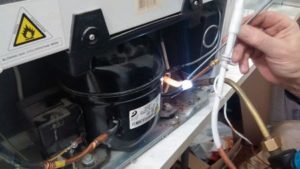Compressor class
The content of the article
- Compressor class
- Absorption class
- Thermoelectric class
The principle of operation of refrigerators of this type is based on the property of gas to increase its own temperature during compression and to sharply decrease it during expansion. Therefore, the components of the device are as follows: a compressor (sometimes two), providing movement of the refrigerant, the refrigerant itself, an evaporator in which the gas expands and cools, and a condenser that transfers heat from the carrier to the environment Wednesday
The compression system operates as follows. The compressor located at the bottom of the refrigerator delivers freon to the evaporator. The latter is a system of tubes hidden in the walls of the device. There, the gas changes its state of aggregation, dramatically lowering the temperature.

Heat from products in the left-luggage offices is removed. Next, freon moves under high pressure into the condenser - a black grid on the rear wall of the refrigeration equipment. There it gradually cools and, returning to a liquid state, through a capillary tube again begins its path to the evaporator. The cycle repeats exactly until the temperature sensors in the storage chambers give a signal to stop the compressor.
Absorption class
Refrigerators of this class are more familiar to truckers and people living in areas without an organized supply of electricity. The coolant in the absorption devices is a concentrated ammonia solution. The principle of operation is quite simple.
Heating the solution in the separation zone causes the evaporation of ammonia, which in this state enters the evaporator. There, due to expansion, it reduces its own temperature and takes on the heat of the products in the chambers.

Further, the path of the refrigerant lies in the absorption chamber, where it is mixed with its own less concentrated solution. This zone is cooled naturally or thanks to the integrated fans. After which the whole mixture is again fed into the heating chamber. The cycle is repeated until the desired temperature regime is reached in the food storage chambers.
Unlike compression devices, this type of refrigerator has a narrow scope. It does not give high performance and is considered quite dangerous equipment due to the chemical characteristics of the refrigerant. However, the design features make it very convenient in its segment.
Thermoelectric class
The principle of operation of this class of refrigeration equipment is direct heat absorption. The absence of a coolant and a circulation system make thermoelectric devices quite simple in terms of design. The role of the cooler is played by two semiconductors connected in the form of a plate.

Reference! The operation of thermoelectric installations is based on the Peltier effect, when when passing an electric current through the contact point of two semiconductors, energy transfer from one to the other occurs.
Thus, the cooling plate under the influence of electric current reduces its temperature and takes heat from the products in the refrigerator. It is worth noting that applying voltage with reverse polarity gives the exact opposite effect - the plate heats up.
There are devices in which the plate can cool to -6 ° C, but they belong to the category of expensive models. Thermoelectric refrigerators cool products for a very long time, however, devices are very popular. Their volumes range from small containers for drinks to chambers with a capacity of several tens of liters.


